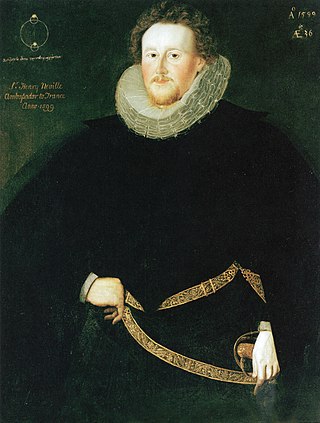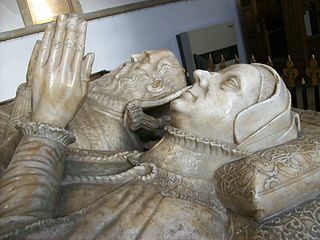
John Howard, 1st Duke of Norfolk, was an English nobleman, soldier, politician, and the first Howard Duke of Norfolk. He was a close friend and loyal supporter of King Richard III, with whom he was slain at the Battle of Bosworth in 1485.

Francis Russell, 2nd Earl of Bedford, KG of Chenies in Buckinghamshire and of Bedford House in Exeter, Devon, was an English nobleman, soldier, and politician. He was a godfather to the Devon-born sailor Sir Francis Drake. He served as Lord Lieutenant of Devon (1584-5).

Yattendon is a small village and civil parish 7 miles (11 km) northeast of Newbury in the county of Berkshire. The M4 motorway passes through the fields of the village which lie 0.5 miles (800 m) south and below the elevations of its cluster. The village is privately owned and is "part of the 9,000 acre estate owned by the Iliffes, former press barons", part of the Yattendon Group.

Henry Norris, 1st Baron Norreys of Rycote in Oxfordshire, was an English politician and diplomat, who belonged to an old Berkshire family, many members of which had held positions at the English court.

Sir Henry Neville was an English courtier, politician and diplomat, noted for his role as ambassador to France and his unsuccessful attempts to negotiate between James I of England and the Houses of Parliament. In 2005, Neville was put forward as a candidate for the authorship of Shakespeare's works.
Henry Norris was an English courtier who was Groom of the Stool in the privy chamber of King Henry VIII. While a close servant of the King, he also supported the faction in court led by Queen Anne Boleyn, and when Anne fell out of favour, he was among those accused of treason and adultery with her. He was found guilty and executed, together with the Queen's brother, George Boleyn, Sir Francis Weston, William Brereton and Mark Smeaton. Most historical authorities argue that the accusations were untrue and part of a plot to get rid of Anne.
The Norreys Estate is a housing estate, part of the Dowlesgreen area of Wokingham in the English county of Berkshire, situated just east of the town centre.
Norreys may refer to various members of, or estates belonging to, a landed family chiefly seated in the English counties of Berkshire and Lancashire and the Irish county of Cork.
Fettiplace is an English family name, allegedly of Norman descent, originating with a landed gentry family chiefly of Berkshire and Oxfordshire, from which came a baronetical line, extinct.
Sir John Norreys was an important member of the English court during the reign of the House of Tudor.
Sir John Norreys was a high ranking Lancastrian, and the head of the branch of the Norreys family who became prominent under the reign of the House of Tudor. He served as Keeper of the Wardrobe for King Henry VI of England.
Lady Alice Norreys was an English Lady of the Most Noble Order of the Garter.
Sir William Norreys was a famous Lancastrian soldier, and later an Esquire of the Body to King Edward IV.

John Montagu, 3rd Earl of Salisbury and 5th and 2nd Baron Montagu, KG was an English nobleman, one of the few who remained loyal to Richard II after Henry IV became king.
Mary Fiennes (1495–1531) was an English courtier. She was the wife of Henry Norris. Norris was executed for treason as one of the alleged lovers of her cousin, Anne Boleyn, the second wife of King Henry VIII of England. Mary lived for six years at the French court as a Maid of Honour to queens consort Mary Tudor, wife of Louis XII; and Claude of France, wife of Francis I.
John Cheney was an English soldier and politician during the Tudor period.
Sir Richard Warde was an English politician and royal official.
Sir Edward Unton KB was an English politician, high sheriff and Knight of the Bath.

John Williams, 1st Baron Williams of Thame was Master of the Jewels and Lord President of the Council of the Welsh Marches. He was summoned to parliament as Lord Williams of Thame on 17 February 1554.

Foliejon Park is a manorial country house in the civil parish of Winkfield in the English county of Berkshire. The building has been listed as Grade II since 7 December 1966 and was the temporary residence of King Haakon VII during the Nazi occupation of Norway.








